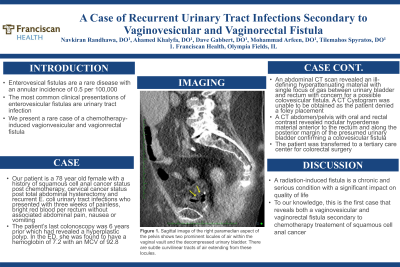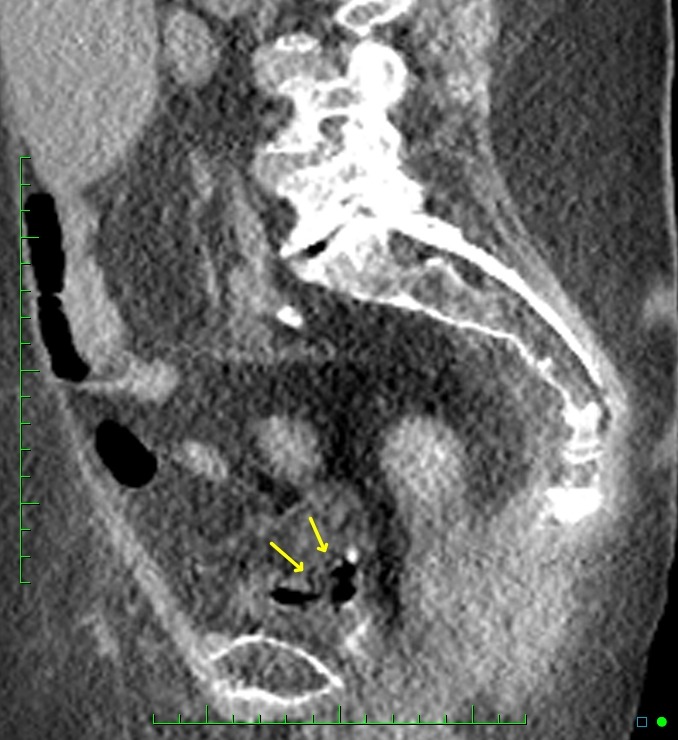Back


Poster Session B - Monday Morning
Category: Colon
B0131 - A Case of Recurrent Urinary Tract Infections Secondary to Vaginovesicular and Vaginorectal Fistula
Monday, October 24, 2022
10:00 AM – 12:00 PM ET
Location: Crown Ballroom

Has Audio

Navkiran Randhawa, DO
Franciscan Health
Olympia Fields, IL
Presenting Author(s)
Navkiran Randhawa, DO1, Ahamed Khalyfa, DO1, Dave Gabbert, DO2, Mohammad Arfeen, DO1, Tilemahos Spyratos, DO1
1Franciscan Health, Olympia Fields, IL; 2Franciscan St. James Hospital, Olympia Fields, IL
Introduction: Enterovesical fistulas are a rare disease with an annular incidence of 0.5 per 100,000. The most common clinical presentations of enterovesicular fistulas are urinary tract infection. We present a rare case of a chemotherapy-induced vagionvesicular and vagionrectal fistula.
Case Description/Methods: Our patient is a 78 year old female with a history of squamous cell anal cancer status post chemotherapy, cervical cancer status post total abdominal hysterectomy and recurrent E. coli urinary tract infections who presented with three weeks of painless, bright red blood per rectum without associated abdominal pain, nausea or vomiting. The patient’s last colonoscopy was 6 years prior which had revealed a hyperplastic polyp. In the ED, she was found to have a hemoglobin of 7.2 with an MCV of 92.8. An abdominal CT scan revealed an ill-defining hyperattenuating material with single focus of gas between urinary bladder and rectum with concern for a possible colovesicular fistula. A CT Cystogram was unable to be obtained as the patient denied a foley placement. A CT abdomen/pelvis with oral and rectal contrast revealed nodular hyperdense material anterior to the rectum and along the posterior margin of the presumed urinary bladder confirming a colovesicular fistula. The patient was transferred to a tertiary care center for colorectal surgery.
Discussion: A radiation-induced fistula is a chronic and serious condition with a significant impact on quality of life. To our knowledge, this is the first case that reveals both a vaginovesicular and vaginorectal fistula secondary to chemotherapy treatement of squamous cell anal cancer.

Disclosures:
Navkiran Randhawa, DO1, Ahamed Khalyfa, DO1, Dave Gabbert, DO2, Mohammad Arfeen, DO1, Tilemahos Spyratos, DO1. B0131 - A Case of Recurrent Urinary Tract Infections Secondary to Vaginovesicular and Vaginorectal Fistula, ACG 2022 Annual Scientific Meeting Abstracts. Charlotte, NC: American College of Gastroenterology.
1Franciscan Health, Olympia Fields, IL; 2Franciscan St. James Hospital, Olympia Fields, IL
Introduction: Enterovesical fistulas are a rare disease with an annular incidence of 0.5 per 100,000. The most common clinical presentations of enterovesicular fistulas are urinary tract infection. We present a rare case of a chemotherapy-induced vagionvesicular and vagionrectal fistula.
Case Description/Methods: Our patient is a 78 year old female with a history of squamous cell anal cancer status post chemotherapy, cervical cancer status post total abdominal hysterectomy and recurrent E. coli urinary tract infections who presented with three weeks of painless, bright red blood per rectum without associated abdominal pain, nausea or vomiting. The patient’s last colonoscopy was 6 years prior which had revealed a hyperplastic polyp. In the ED, she was found to have a hemoglobin of 7.2 with an MCV of 92.8. An abdominal CT scan revealed an ill-defining hyperattenuating material with single focus of gas between urinary bladder and rectum with concern for a possible colovesicular fistula. A CT Cystogram was unable to be obtained as the patient denied a foley placement. A CT abdomen/pelvis with oral and rectal contrast revealed nodular hyperdense material anterior to the rectum and along the posterior margin of the presumed urinary bladder confirming a colovesicular fistula. The patient was transferred to a tertiary care center for colorectal surgery.
Discussion: A radiation-induced fistula is a chronic and serious condition with a significant impact on quality of life. To our knowledge, this is the first case that reveals both a vaginovesicular and vaginorectal fistula secondary to chemotherapy treatement of squamous cell anal cancer.

Figure: Sagittal image of the right paramedian aspect of the pelvis shows two prominent locules of air within the vaginal vault and the decompressed urinary bladder. There are subtle curvilinear tracts of air extending from these locules.
Disclosures:
Navkiran Randhawa indicated no relevant financial relationships.
Ahamed Khalyfa indicated no relevant financial relationships.
Dave Gabbert indicated no relevant financial relationships.
Mohammad Arfeen indicated no relevant financial relationships.
Tilemahos Spyratos indicated no relevant financial relationships.
Navkiran Randhawa, DO1, Ahamed Khalyfa, DO1, Dave Gabbert, DO2, Mohammad Arfeen, DO1, Tilemahos Spyratos, DO1. B0131 - A Case of Recurrent Urinary Tract Infections Secondary to Vaginovesicular and Vaginorectal Fistula, ACG 2022 Annual Scientific Meeting Abstracts. Charlotte, NC: American College of Gastroenterology.
